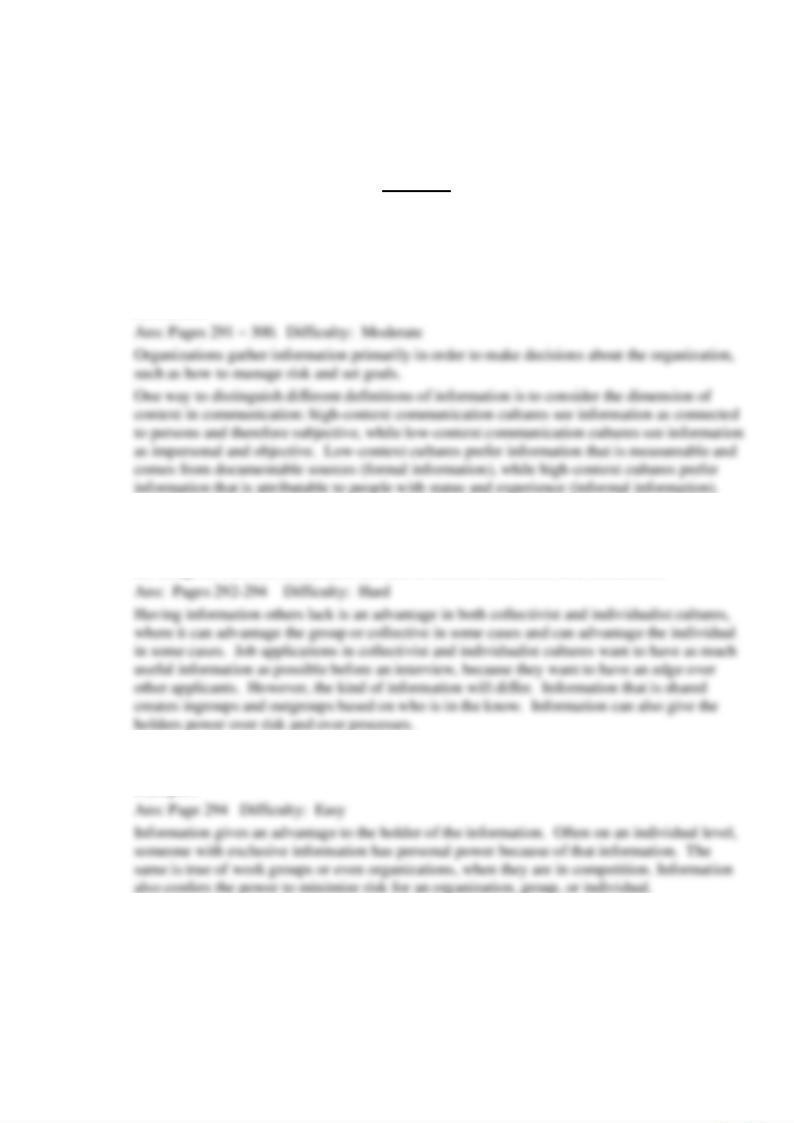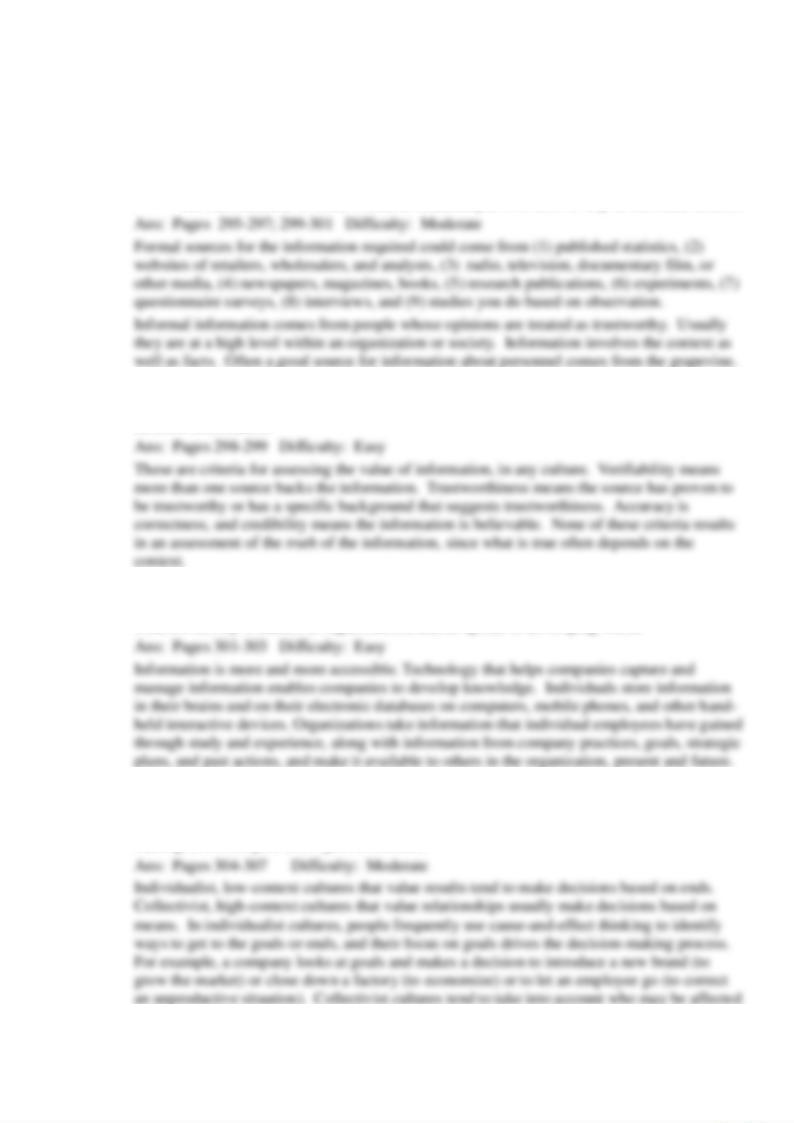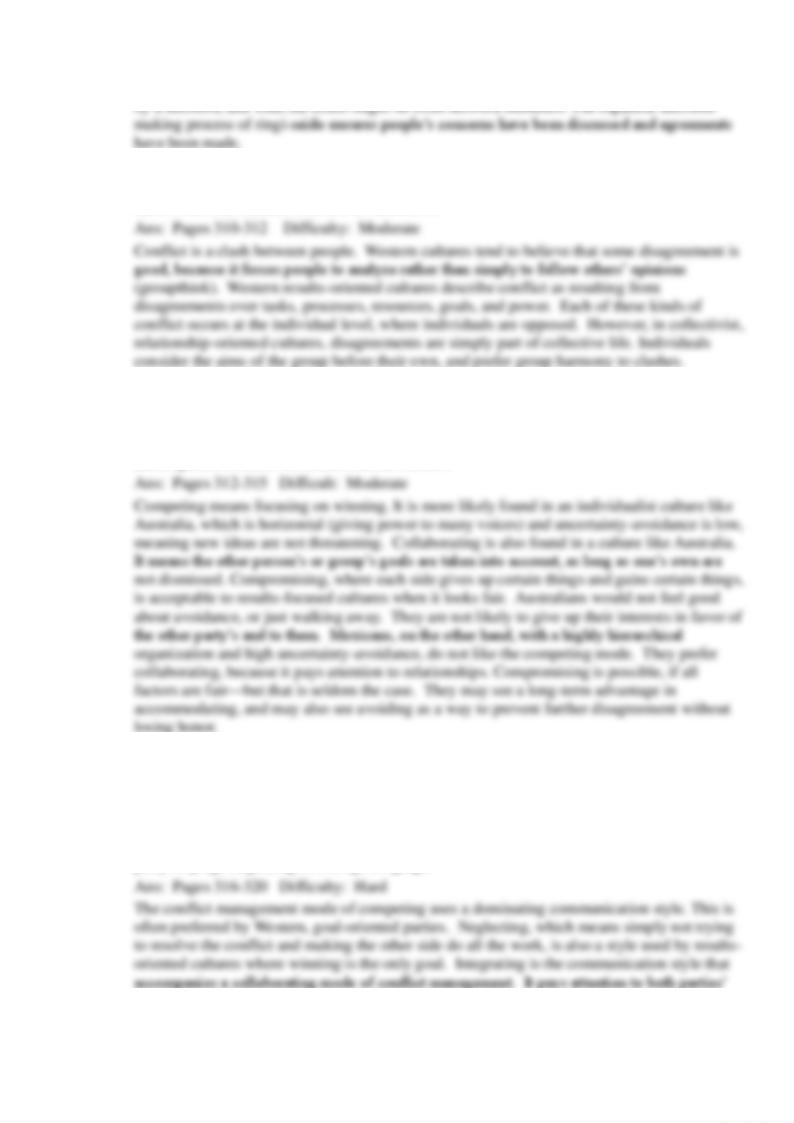
CHAPTER 8
INFORMATION, DECISIONS, AND SOLUTIONS
Test Bank
Essay Questions
1. Discuss why information is gathered by organizations and how information is defined
differently in different cultures, and then explain what implications this has for foreign
businesses.
2. The possession of information leads to an advantage in all cultures. Explain how information
might be an advantage in an individualist culture and then compare how it might be an
advantage in a collectivist culture. Be sure to mention similarities and differences.
3. Discuss the statement "Information is power." Choose two different cultures and use specific
examples.
4. You have been asked by your employer to gather data about the costs of producing a
continuous-curl potato chip. Your company has the opportunity to buy the rights to a patented
machine, but your boss wants to know how much the raw materials (potato, salt, oil,),
warehousing, maintenance (blades, motors), and processing will cost.

⚫ List at least six formal sources you would trust to generate the required data.
⚫ Now explain how you could gather the same information in Patatinia, a country where
a) you are not allowed Internet access, b) you may not go to a library, c) the periodicals
and books available have biased perspectives that you feel are untrustworthy, and d) the
supply of potatoes is seasonal. (Assume you have nobody at home who could send you
the information.) In other words, in Patatinia you will have to rely on informal sources.
5. Explain the meanings of verifiability, trustworthiness, accuracy and credibility as applied to
business information.
6. Discuss Information Management within the context of business communication. Explain
what IM is, why it matters to organizations, and its spread in developing world.
7. Compare how individuals and organizations make decisions based on ends or based on means.
Explain the cultural priorities (the impact of culture on the organizations) involved in decision
making. Use examples from specific cultures.

by a decision, and what the effect might be from network members. The Japanese decision-
8. Define conflict and discuss the five factors that lead to conflict in Western cultures, relating
them to the individualist-collectivist dimension.
9. Possible modes for managing conflict include competing, collaborating, compromising,
avoiding, and accommodating. Define and explain each one, showing how each is related to
cultural dimensions and characteristics from a specific individualist culture such as Australia
and a specific collectivist culture such as Mexico.
10. Eight conflict communication styles have been proposed that correspond to the five conflict
management modes identified in question 9, and add another three. Discuss the five modes
and the communication styles for each one, plus the additional three communication
approaches. Give examples from specific cultures. (The communication styles are
dominating, neglecting (passive-aggressive behavior), integrating, emotion-expressing, third-
party helping, bargaining, avoiding, obliging.)

goals, and is the preferred approach by collectivist, relationship-oriented cultures. Emotion-
11. Information is useful for making decisions in any culture.
12. Business information in any culture is defined the same way.
13. Informal, subjective information does not come from the grapevine.
14. In low-context cultures, information is contained in measurable units.
15. Two key criteria for assessing information are validity and reliability
16. Low-context managers think that information that is objective has a greater degree of accuracy.
17. Information that is verifiable is information that has been verified by the source.
18. Formal information is not information that is found online.
.
19. Informal information sources are not very reliable.

20. Information management in companies today requires technology to capture and store
information.
21. How people in a culture makes decisions is an important factor in cross-cultural encounters.
22. One way to look at culture’s effect on decision making is whether decisions are made based on
ends or on beginnings.
23. No decision-making style discussed in the textbook can be found in just about every culture.
24. A problem is a problem, defined the same way no matter what the culture.
25. All problems are conflicts.
26. Americans groupthink is preferable to conflict.
27. The best way to handle conflict in any culture is to talk it out frankly and openly.
28. In results cultures like the United States, conflict is not usually viewed as having the potential
to damage relationships.
29. Collaborating is a conflict management mode that is encouraged in individualist cultures.
30. Obliging communication is typical in the mode of conflict management termed avoiding.
31. Which of the following was NOT a key decision made by Brittanica that was critical to
keeping its information business going?
a. to allow anyone to edit its encyclopedia online

b. to publish the entire encyclopedia on the internet
c. to keep the quality of its information at the highest level
d. to make Brittanica available as an application for iPhone, Blackberry and others
32. High-context cultures
a. rely on information that comes in measurable units
b. view information as externalized, outside of people
c. view information with reference to the context
d. prefer information that is quantifiable
33. Formal information comes from all EXCEPT
a. observation
b. opinion
c. published sources
d. survey
34. Informal information is
a. always subjective
b. usually quantified
c. often from a "grapevine"
d. always verifiable
35. Criteria for assessing business information include:
a. verifiability, frequency, accuracy, and repeatability
b. verifiability, accuracy, trustworthiness, and frequency
c. credibility, accuracy, verifiability, and trustworthiness
d. credibility, verifiability, trustworthiness, and repeatability
36. People in ends-oriented cultures make decisions:
a. that are often the result of cause-and-effect thinking
b. that put group goals before individual goals
c. that take into account the honor of the organization
d. that reflect the importance of trustworthiness

37. Problems in organizations:
a. can be defined the same way in all cultures
b. are often blamed on the most high-status person in collectivist cultures
c. are often externalized and objectified in low-context cultures
d. are quickly solved by discussion in all cultures
38. A generalization about conflicts in individualist organizations is that they can involve:
a. disagreements over tasks, resources, personalities, and hierarchies
b. open discussion about the conflict
c. efforts above all to preserve harmony
d. agreement by junior members with the most senior members
39. The mode of managing conflict that high-context cultures tend to prefer more than low-context
cultures is
a. competing
b. accommodating
c. winning
d. achieving
40. Strategies for communication in conflict across cultures, when members of high-context
cultures disagree with members of low-context cultures, are:
a. encouraging both sides to make statements about what they see is wrong
b. getting both sides to listen, express agreement where they can, and identify common
goals
c. using the ringi-seido process
d. using only hard data to validate information